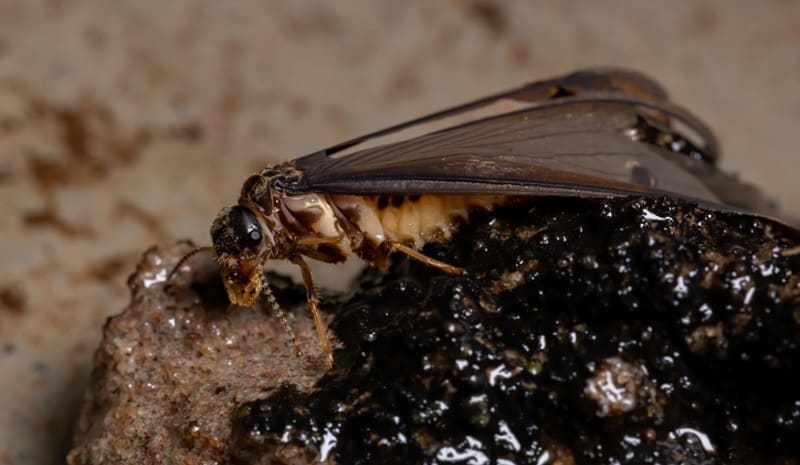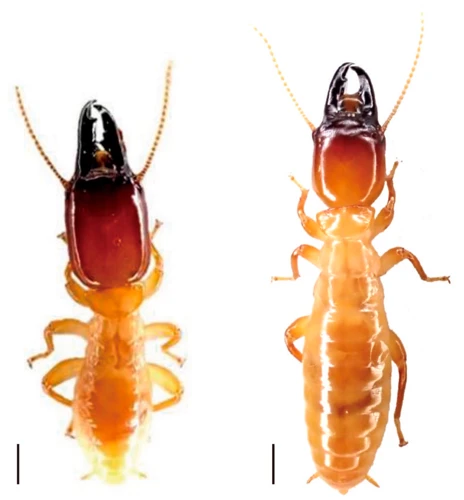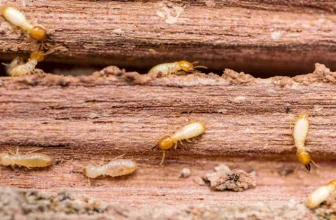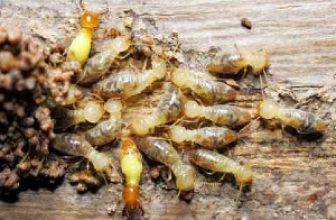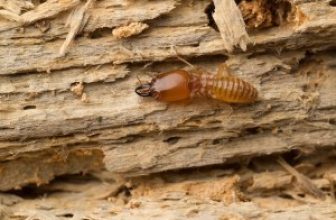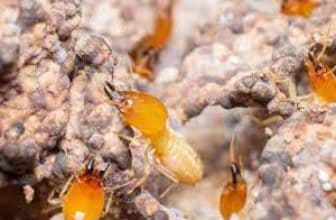As we gaze out into the natural world, there are many creatures and organisms that are constantly buzzing around, fulfilling their purpose in life. However, among all these fascinating creatures, one stands out for their remarkable communication abilities – termites. These tiny insects have an intricate social system that allows them to work together in a seamless and efficient manner. But have you ever wondered how termites are able to communicate with one another? How do they convey information such as where food and shelter can be found? In this article, we will delve into the complex mechanisms that termites use to communicate, including chemical, physical, and mental forms of communication. So hold on tight, and prepare to be amazed by the fascinating world of termite communication!
Termites’ Social Organization
The world of termites is a complex and fascinating one. These small insects are known for building impressive mounds and colonies, which can contain millions of individual termites. However, what truly sets them apart from other insects is their social organization. Termites have a unique caste system, where each member is assigned specific tasks in order to keep the colony running smoothly.
This system of task allocation and social organization is crucial for the survival and success of the colony. In this section, we will explore the intricacies of termites’ social organization and the roles each caste plays in their community. To learn more about the significance of termites in the ecosystem, check out our article on termites’ role in the ecosystem.
Termite Castes
Termites are social insects living in colonies with a strict hierarchical structure. Each colony comprises members of different castes, each of which has unique physical characteristics and performs specific tasks.
The three primary castes in a termite colony are:
- Worker termites
- Soldier termites
- Reproductive termites
Worker termites are the most populous caste in a termite colony. They are responsible for maintaining and building the nest, as well as caring for immature termites. Their physical appearance is typically light-colored and soft-bodied. Worker termites are blind, wingless, and often do not have functional reproductive organs. They also serve as intermediaries in the communication between other castes in the colony.
Soldier termites are less populous than the workers. They possess large heads with powerful mandibles for defending the colony against attacks by predators. Their physical appearance is similar to that of workers, although their bodies are often darker in color. Soldiers are also wingless, blind, and sterile.
Reproductive termites, often referred to as swarmers or alates, are responsible for establishing new colonies by mating and laying eggs. They are the least populous caste in the colony, and their physical appearance differs significantly from that of workers and soldiers. Reproductive termites possess wings, which allow them to fly away from the nest and seek out new mates and establish new colonies. After they mate, they drop their wings, and the females become queens of the new colony.
Here you can find more information on the signs of termite infestation.
Task allocation is an essential part of the termite social organization. By assigning individuals to specific tasks, termites ensure that the colony runs efficiently and effectively. Pheromones play a vital role in task allocation, providing communication among individuals in the colony, allowing them to work together to meet the needs of the group.
Chemical Communication
When it comes to effective communication, humans have a wide range of tools to choose from, such as words, body language, and facial expressions. Termites, on the other hand, rely mainly on chemical signals to communicate with each other. Using intricate chemical communication mechanisms, termites are able to coordinate their behaviors and act as a cohesive unit. Let’s take a closer look at the fascinating world of termite chemical communication and discover how it works. But first, let’s briefly remind ourselves of some relevant physical characteristics of termites that play a role in communication, especially in conveying or receiving chemical signals.
Role of Pheromones
Pheromones play a significant role in the social organization and communication of termites. Pheromones are chemical compounds that termites use to communicate with each other. These compounds are produced by the termites and released into the environment, where they can be picked up by other members of the colony. Pheromones can signal alarm, danger, food sources, and the presence of other termites. They can be detected through the sense of smell, which is one of the most important senses that termites possess.
The use of pheromones is crucial for termite colonies because it helps them remain organized and effectively manage their tasks. By using pheromones, termites can communicate the location of food sources and initiate the recruitment of other termites to collect the food. This leads to efficient food gathering and allocation of tasks among the colony members. In fact, pheromones are responsible for the entire organization of a termite colony, from the division of labor to the creation of specialized castes.
Pheromones are vital for the survival of termite colonies, and termites use these chemicals to communicate with each other, organize their tasks, establish territories, and grow their population. If you want to learn more about subterranean termite mating behaviors, follow this link: subterranean termite mating.
How Pheromones Work
Pheromones are chemicals that play a crucial role in termite communication. These chemicals are produced by the termites and are detected by the receptors in the antennae of other termites. Here’s how pheromones work in termite communication:
1. Identification: Pheromones are used in termite communication to identify members of a specific colony. Each colony has its own unique odor, which is identified by the pheromones produced by the termites.
2. Alarm: When a termite is threatened, it releases alarm pheromones to alert other members of the colony. This leads to the activation of defense mechanisms, which help protect the colony from danger.
3. Aggregation: Pheromones play a role in the aggregation of termites. When termites find a food source, they release aggregation pheromones to attract other members of the colony to the food source. This helps in the efficient utilization of resources.
4. Trail: Trail pheromones are used to mark a path from the colony to a food source. When a termite finds food, it releases trail pheromones to mark the path for other members of the colony. This helps in the quick and efficient transportation of food back to the colony.
5. Reproduction: Pheromones also play a role in the reproduction of termites. When a termite queen is ready to mate, she releases sex pheromones to attract males from the colony. The male termites then release aggregation pheromones to attract other males and form a swarm.
Each type of pheromone plays a crucial role in the communication and coordination of termite colonies. The ability of termites to use these chemical signals to coordinate their activities and respond to different situations is a fascinating example of the complexity of insect communication.
Physical Communication
Among all the animals, termites are known to have a remarkable communication mechanism that helps them organize themselves and carry out tasks efficiently. While pheromones play a crucial role in their communication, it is worth noting that termites also use physical means of communication to interact with each other. The physical communication of termites includes the production of vibrations and sounds. Understanding how termites use these physical means to convey messages is fascinating and perplexing. Let’s take a closer look at how termites communicate physically.
Role of Vibrations and Sounds
Termites are not only capable of communicating through chemicals but also through vibrations and sounds. These physical cues play a significant role in their social organization and interactions.
Vibrations:
Termites use vibrations to send signals to their colony mates, alerting them about potential threats or disturbances. These vibrations are produced when termites tap their heads against the walls of their galleries or when they drum their abdomens against a substrate. The vibrations can travel through the nest and be felt by other termites.
Sounds:
Termites also produce sounds by rubbing their mandibles together or by banging their heads against a surface. These sounds can carry through the nest and serve as a means of communication between colony members.
These vibrations and sounds are often used by soldier termites as a warning signal when they detect predators or disturbances. The vibrations and sounds can also be used in responding to food cues or to alert other termites about new discoveries.
Role in physical communication:
Vibrations and sounds in termites play a crucial role in their social hierarchy as well. In order to maintain the structural integrity of their nest, termites need to communicate and coordinate their efforts to carry out repairs. The workers use vibrations and sounds to signal to the soldiers and other workers where repairs are necessary. The soldiers and workers then respond by coming together to carry out the necessary repairs.
Termites use physical communication as a means of efficiently coordinating their efforts for the survival of the colony. The vibrations and sounds they produce play a critical role in warning colony members about potential threats, responding to food cues, and maintaining the structural integrity of their nest.
Mental Communication
As social organisms, termites rely on more than just chemical and physical communication to interact with one another. They also engage in intricate mental communication that helps them make decisions as a group and learn from their experiences. Through their incredible memory and ability to work collectively, termites have established a sophisticated system of mental communication that enables them to thrive in their complex societies. Let’s explore the fascinating world of termite mental communication and how it shapes their behavior.
Role of Memory
Memory plays a crucial role in termites’ communication and decision-making processes. Termites’ ability to remember important information helps them to navigate their environment, communicate with their colony members and make collective decisions about tasks like foraging or building their nests.
Termites store their memories in their central nervous system. They have a brain and a ventral nerve cord that controls their movements and responses to stimuli. The ventral nerve cord is located along the length of the termite’s body and connects the brain to the rest of its nervous system, allowing rapid communication between the two.
How Termites Use Memory
Termites use their memory to make decisions as a colony. When a termite detects for example a new food source, it will communicate this information to its colony members by laying down a trail of pheromones. The other termites will then follow this trail and learn to associate it with the location of the food source. This way, the entire colony can gather food more efficiently.
Termites also use their memories to learn from experience. For example, if a termite was to encounter a predator, it would remember the danger and avoid the area in the future. In this way, the colony can avoid danger and increase its chances of survival.
| Termites’ Memory Abilities | Termites’ Memory Examples |
|---|---|
| Recognizing colony members | Being able to recognize the queen termite and other members of the colony hierarchy |
| Remembering locations | Remembering the location of food sources, nest sites, and other important landmarks |
| Differentiating between substances | Being able to differentiate between safe and dangerous substances in their environment |
| Learning from experience | Remembering encounters with predators and avoiding areas of danger in the future |
The Advantages of Collective Memory
Collective memory allows termites to make collaborative decisions that benefit the entire colony. By sharing information about food sources and navigating their environment together, termites can work together more efficiently and respond effectively to changes in their environment.
Their memory allows for the efficient distribution of tasks throughout the colony. Certain termites, for example, are tasked with foraging for food, while others are responsible for constructing nests. By remembering each other’s roles in the colony, termites can work together more efficiently and achieve greater success.
Termites’ memory plays an important role in their communication and decision-making processes. Their ability to remember information about their environment and individual colony members is crucial to their collective success. By working together efficiently and making informed decisions, termites can thrive and continue to build and strengthen their colonies.
How Termites Learn from Experience
Termites are known for their ability to learn from experience. This trait is crucial for their survival and growth within their colony. These tiny creatures can remember things that are vital for their survival, such as the location of food sources, shelter spots, and potential threats.
Here are some ways that termites learn from experience:
- Observation: Termites observe and learn from the actions of other termites in their colony. They observe the behavior of their peers and adapt their own behavior accordingly.
- Association: Termites can associate different stimuli with certain behaviors. For example, termites may associate the smell of a predator with danger, prompting them to retreat or take defensive measures.
- Conditioning: Through classical conditioning, termites can learn to associate an otherwise neutral stimulus with a particular response. This type of conditioning can be used to train termites for specific tasks, such as locating food sources.
- Memory: Termites have a good memory and can remember important information for a long time. They use their memory to remember the locations of key resources such as food, water, and shelter.
This ability to learn from experience is essential for the survival of the colony, as it enables termites to adapt to changing conditions and find new resources when necessary. By working together and sharing information through chemical and physical communication, termites can learn quickly and efficiently, allowing them to thrive in a variety of environments.
How Termites Make Collective Decisions
One way termites make collective decisions is through a process called ‘aggregate decision-making’. In this process, groups of termites physically aggregate around potential nest sites or food sources and use chemical communication to assess the quality of each option. Termites use strong-smelling pheromones called ‘trail pheromones’ to explore potential sites, and when they find a promising one, they release a different type of pheromone called ‘recruitment pheromones’ to attract other termites to the site. This creates a positive feedback loop in which more and more termites are attracted to the site until a critical mass is reached and the colony adopts it as their new location.
Another way termites make collective decisions is through a process called ‘quorum sensing’. In quorum sensing, termites use chemical signals to monitor the size and activity level of their colony. When enough termites sense that a critical mass has been reached or that resource levels are dwindling, they collectively switch from one behavior to another. For example, when food stores run low, termites may switch from foraging to food storage and conservation, or when their nest becomes too small, they may switch to building a new nest.
Collective decision-making in termites is a fascinating process that involves a combination of chemical, physical, and behavioral cues. Through the use of pheromones, vibrations, and sound signals, termites are able to communicate with each other and make informed decisions about the future of their colony. It is a reminder of how complex and intelligent social insects like termites can be.
Conclusion
As we delve deeper into the mysterious world of termites, it becomes clear that these minuscule creatures have a highly sophisticated means of communication. From chemical cues to physical vibrations and even mental processes, their communication mechanisms are highly complex and tightly intertwined with their social organization.
Overall, the study of termite communication mechanisms is still a young and evolving field, with much left to be discovered. But by gaining a better understanding of how these tiny insects talk to each other, we can unlock insights that could have important implications for everything from pest control to the study of collective intelligence in biological systems.
Frequently Asked Questions
What Are the Different Termite Castes?
Termites are divided into three castes: workers, soldiers, and reproductives (also known as alates or swarmers).
How Do Termites Allocate Tasks?
Task allocation in a termite colony is highly organized and based on age and physical development. The older and more developed termites take on tasks that require advanced skills and abilities, while younger termites perform simpler tasks.
What Is the Role of Pheromones in Termite Communication?
Pheromones are chemicals that termites use to communicate with each other and coordinate their behavior. They are used to mark trails, locate food sources, and attract mates.
How Do Pheromones Work?
Pheromones work by triggering a specific response in the receiving termite. Some pheromones elicit a specific behavior, such as following a trail, while others may elicit a physiological response, such as the release of a particular hormone.
What Are the Different Types of Pheromones?
There are several types of pheromones used by termites, including trail-following pheromones, alarm pheromones, sex pheromones, and colony recognition pheromones.
What Is the Role of Vibrations and Sounds in Termite Communication?
Vibrations and sounds are used by termites to communicate with each other and coordinate their behavior. They are used to signal danger, locate food sources, and establish nest boundaries.
How Are Vibrations and Sounds Produced?
Vibrations and sounds are produced by termites using their bodies. Soldiers, for example, will bang their heads against the walls of the colony to produce vibrations that signal danger to other members.
What Is the Role of Memory in Termite Communication?
Termites have the ability to remember and recognize certain scents and pheromones. This allows them to identify members of their colony, detect intruders, and locate food sources.
How Do Termites Learn from Experience?
Termites learn from experience through trial and error. For example, if a group of workers discovers a food source that is difficult to reach, they may learn to construct tunnels or bridges to make it easier to access in the future.
How Do Termites Make Collective Decisions?
Termites make collective decisions through a process known as stigmergy. This involves the interaction of individuals based on the indirect exchange of information through the environment. For example, one termite may leave a pheromone trail to indicate the location of food, which is then followed by others.
References
Contents
Why You Should Trust Pest Control Hacks?
We know that pests are nasty neighbors, and it can take months to eliminate them without the right approach. Our experts use their own experience to compile articles and guides that are introductory and informative. Our authors’ opinions are independent and based on the results of practical testing of pest control tools. We do not notify manufacturers of testing of their products and do not receive payment from them for posting their items. Also, our texts are never submitted to company representatives for proofreading before placement. On the site, you will find exclusively objective ratings and reviews.

